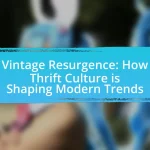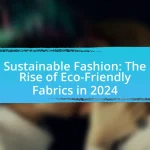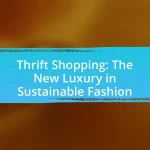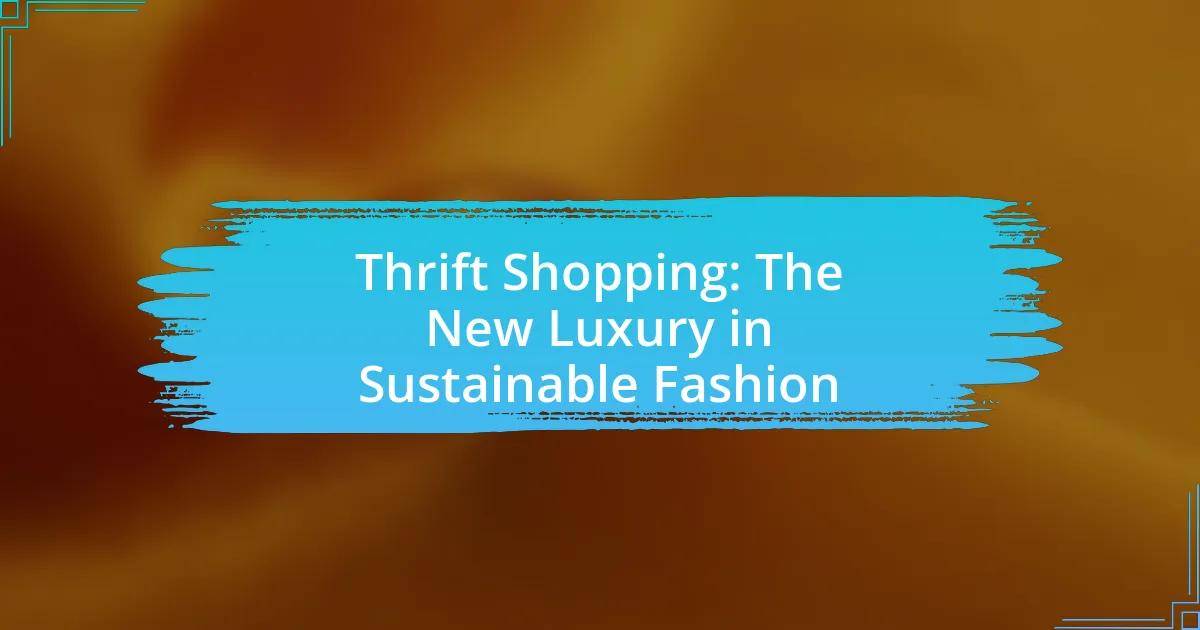The article focuses on the future of sustainable fashion, highlighting key trends such as the rise of circular economy practices, the increased use of eco-friendly materials, and the adoption of technology for transparency in supply chains. It examines how consumer behavior is influencing these trends, driven by heightened environmental awareness and the impact of social media. The article also discusses the role of brands in promoting sustainability, the innovations expected in the next decade, and the challenges faced in implementing sustainable practices. Additionally, it provides insights on how consumers can actively participate in supporting sustainable fashion through informed purchasing decisions and engagement with eco-friendly initiatives.
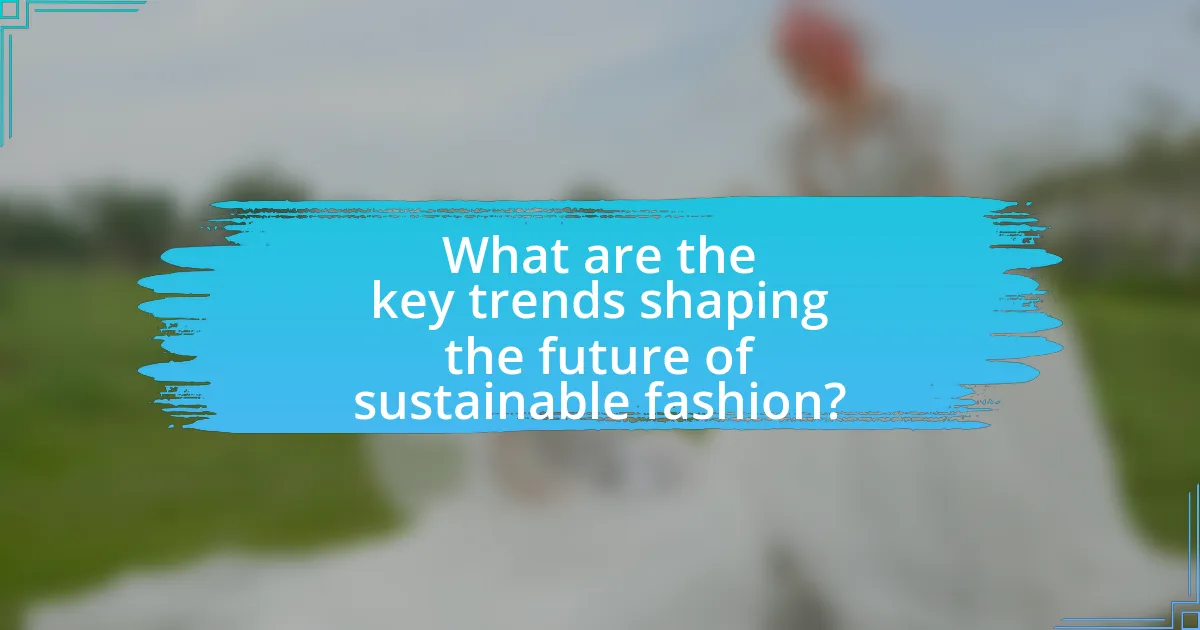
What are the key trends shaping the future of sustainable fashion?
Key trends shaping the future of sustainable fashion include the rise of circular economy practices, increased use of eco-friendly materials, and the adoption of technology for transparency and traceability. Circular economy practices, such as recycling and upcycling, are gaining traction as brands aim to minimize waste and extend the lifecycle of garments. The use of eco-friendly materials, including organic cotton, Tencel, and recycled polyester, is becoming more prevalent, driven by consumer demand for sustainable options. Additionally, technology is enhancing transparency in supply chains, with blockchain and digital platforms enabling consumers to track the origins and sustainability of their clothing, thereby fostering informed purchasing decisions. These trends are supported by research indicating that the global sustainable fashion market is projected to reach $8.25 billion by 2023, reflecting a significant shift towards environmentally conscious consumer behavior.
How is consumer behavior influencing sustainable fashion trends?
Consumer behavior is significantly influencing sustainable fashion trends by driving demand for eco-friendly products and ethical practices. As consumers become more aware of environmental issues, they increasingly prefer brands that prioritize sustainability, leading to a rise in the popularity of recycled materials and transparent supply chains. For instance, a 2021 survey by McKinsey & Company found that 67% of consumers consider the use of sustainable materials important when making fashion purchases. This shift in consumer preferences compels brands to adopt sustainable practices to remain competitive, thereby shaping the future landscape of the fashion industry.
What factors are driving consumers towards sustainable choices?
Consumers are increasingly driven towards sustainable choices due to heightened environmental awareness, ethical considerations, and the influence of social media. Research indicates that 66% of global consumers are willing to pay more for sustainable brands, reflecting a shift in purchasing behavior towards eco-friendly products. Additionally, the rise of climate change activism and transparency in supply chains has made consumers more conscious of the environmental impact of their purchases, leading to a preference for brands that prioritize sustainability.
How do social media and influencers impact sustainable fashion awareness?
Social media and influencers significantly enhance sustainable fashion awareness by leveraging their platforms to disseminate information and promote eco-friendly brands. Influencers often share personal experiences with sustainable fashion, which resonates with their followers and encourages them to adopt similar practices. For instance, a study by the Global Fashion Agenda found that 62% of consumers are influenced by social media when making sustainable fashion choices. This demonstrates that social media serves as a powerful tool for educating audiences about sustainable practices and fostering a community around eco-conscious consumption.
What role do brands play in promoting sustainability in fashion?
Brands play a crucial role in promoting sustainability in fashion by implementing eco-friendly practices and influencing consumer behavior. They achieve this through sustainable sourcing of materials, reducing waste in production, and adopting transparent supply chains. For instance, brands like Patagonia and Stella McCartney have pioneered the use of recycled materials and ethical labor practices, setting industry standards. Research indicates that 66% of consumers are willing to pay more for sustainable brands, highlighting the impact of brand commitment on consumer choices. By prioritizing sustainability, brands not only enhance their market position but also contribute to broader environmental goals.
Which brands are leading the way in sustainable practices?
Patagonia, Nike, and Stella McCartney are leading the way in sustainable practices. Patagonia is renowned for its commitment to environmental activism and uses recycled materials in its products, with over 69% of its materials sourced sustainably. Nike has implemented its Move to Zero initiative, aiming for zero carbon and zero waste, and has introduced products made from recycled materials, such as its Flyleather shoes. Stella McCartney is a pioneer in sustainable luxury fashion, utilizing organic and recycled materials while advocating for animal welfare and environmental responsibility. These brands exemplify the integration of sustainability into their business models, setting benchmarks for the industry.
How are brands communicating their sustainability efforts to consumers?
Brands are communicating their sustainability efforts to consumers through transparent marketing, eco-labeling, and storytelling. For instance, many companies now highlight their sustainable practices on packaging and websites, providing detailed information about sourcing, production methods, and environmental impact. Research from Nielsen indicates that 66% of global consumers are willing to pay more for sustainable brands, demonstrating the effectiveness of these communication strategies. Additionally, brands utilize social media platforms to share their sustainability journeys, engage with consumers, and foster community discussions around environmental issues, further enhancing their credibility and consumer trust.

What innovations are expected to emerge in sustainable fashion over the next decade?
Innovations expected to emerge in sustainable fashion over the next decade include advanced biodegradable materials, circular economy practices, and AI-driven supply chain optimization. Biodegradable materials, such as mycelium leather and bio-fabricated textiles, will reduce environmental impact by decomposing naturally. Circular economy practices, including clothing rental and recycling programs, will minimize waste and extend the lifecycle of garments. AI-driven supply chain optimization will enhance efficiency, reduce overproduction, and enable more sustainable sourcing of materials. These innovations are supported by increasing consumer demand for eco-friendly products and regulatory pressures for sustainable practices in the fashion industry.
How is technology transforming sustainable fashion production?
Technology is transforming sustainable fashion production by enabling more efficient resource use and reducing waste through innovations such as 3D printing, digital textile printing, and blockchain for supply chain transparency. For instance, 3D printing allows for on-demand production, minimizing excess inventory and material waste, while digital textile printing reduces water and energy consumption compared to traditional methods. Additionally, blockchain technology enhances traceability, allowing consumers to verify the sustainability of materials and practices used in their garments, which supports ethical sourcing and production. These advancements collectively contribute to a more sustainable fashion industry by promoting responsible consumption and minimizing environmental impact.
What advancements in materials are contributing to sustainability?
Advancements in materials contributing to sustainability include the development of biodegradable fabrics, recycled textiles, and innovative alternatives to conventional materials. Biodegradable fabrics, such as those made from organic cotton or Tencel, decompose naturally, reducing landfill waste. Recycled textiles, like those derived from post-consumer plastic bottles, significantly lower the environmental impact by repurposing waste into new garments. Additionally, alternatives such as lab-grown leather and mushroom-based materials offer sustainable options that minimize resource consumption and animal harm. These advancements are supported by research indicating that the fashion industry can reduce its carbon footprint by up to 30% through the adoption of sustainable materials.
How are digital tools enhancing transparency in the fashion supply chain?
Digital tools are enhancing transparency in the fashion supply chain by enabling real-time tracking and data sharing among stakeholders. Technologies such as blockchain provide immutable records of transactions, allowing brands and consumers to verify the origin and journey of products. For instance, companies like Everledger utilize blockchain to trace the provenance of materials, ensuring ethical sourcing and reducing fraud. Additionally, platforms like Provenance and Transparency-One offer digital labels that inform consumers about product details, including manufacturing practices and environmental impact. These tools not only foster accountability but also empower consumers to make informed purchasing decisions, thereby driving demand for sustainable practices in the fashion industry.
What are the potential challenges facing sustainable fashion innovations?
The potential challenges facing sustainable fashion innovations include high production costs, limited consumer awareness, and supply chain complexities. High production costs arise from the use of eco-friendly materials and ethical labor practices, which can deter brands from adopting sustainable methods. Limited consumer awareness hampers demand for sustainable products, as many consumers prioritize price and convenience over sustainability. Additionally, supply chain complexities complicate the implementation of sustainable practices, as brands must navigate various stakeholders and logistics to ensure ethical sourcing and production. These challenges collectively hinder the widespread adoption of sustainable innovations in the fashion industry.
How can brands overcome resistance to change in traditional fashion practices?
Brands can overcome resistance to change in traditional fashion practices by implementing transparent communication strategies that educate stakeholders about the benefits of sustainable practices. For instance, brands can showcase case studies demonstrating how sustainable practices lead to cost savings and improved brand loyalty, as seen in companies like Patagonia, which has successfully integrated environmental responsibility into its business model. Additionally, engaging consumers through participatory initiatives, such as co-designing sustainable products, can foster a sense of ownership and reduce resistance. Research indicates that 66% of global consumers are willing to pay more for sustainable brands, highlighting the market demand for change. By aligning their practices with consumer values and providing clear evidence of the advantages, brands can effectively navigate and mitigate resistance to change.
What regulatory hurdles might impact sustainable fashion initiatives?
Regulatory hurdles that might impact sustainable fashion initiatives include stringent environmental regulations, compliance with labor laws, and restrictions on materials. Environmental regulations often require brands to meet specific sustainability standards, which can increase operational costs and complicate supply chain management. Compliance with labor laws is crucial, as brands must ensure fair labor practices throughout their supply chains, which can be challenging in regions with less stringent enforcement. Additionally, restrictions on certain materials, such as those deemed harmful to the environment, can limit design options and increase production costs. These factors collectively create a complex regulatory landscape that sustainable fashion initiatives must navigate to succeed.
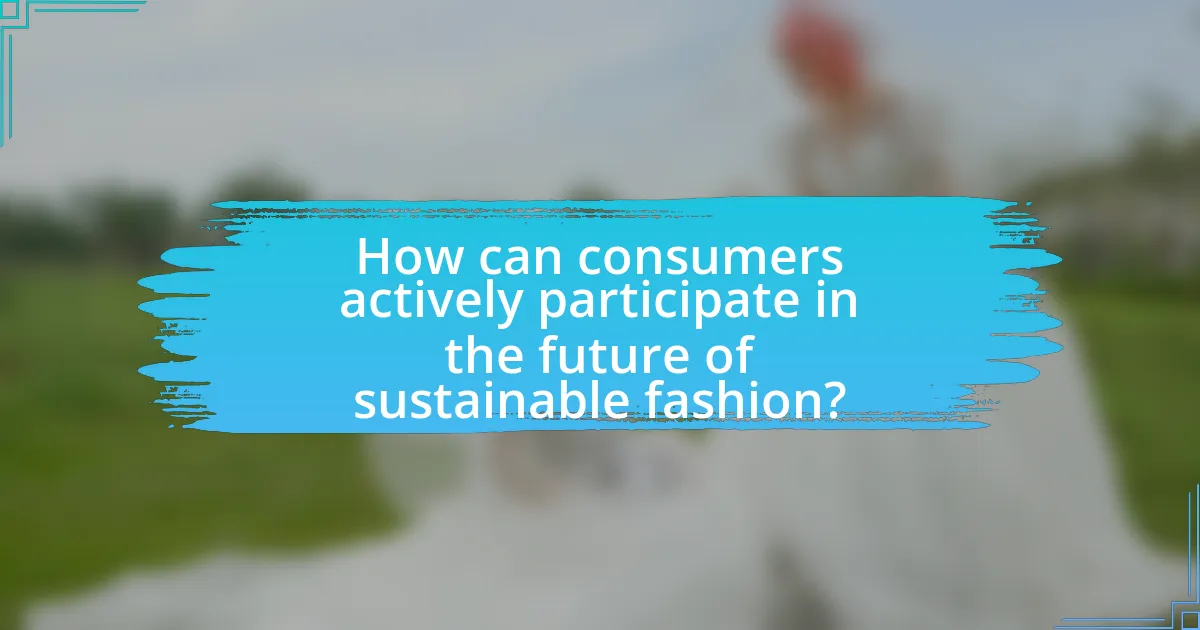
How can consumers actively participate in the future of sustainable fashion?
Consumers can actively participate in the future of sustainable fashion by making informed purchasing decisions that prioritize eco-friendly brands and materials. By choosing to buy from companies that utilize sustainable practices, such as using organic materials or implementing fair labor practices, consumers can drive demand for environmentally responsible products. Research indicates that 66% of global consumers are willing to pay more for sustainable brands, highlighting the market’s potential for growth in this area. Additionally, consumers can engage in practices like recycling clothing, supporting second-hand markets, and advocating for transparency in supply chains, which collectively contribute to a more sustainable fashion ecosystem.
What practical steps can consumers take to support sustainable fashion?
Consumers can support sustainable fashion by choosing to buy from brands that prioritize ethical production practices. This includes researching companies that use eco-friendly materials, ensure fair labor conditions, and minimize waste in their manufacturing processes. According to a 2021 report by the Global Fashion Agenda, sustainable brands are increasingly transparent about their supply chains, which allows consumers to make informed choices. Additionally, consumers can reduce their fashion footprint by purchasing second-hand clothing, participating in clothing swaps, and properly recycling or donating garments they no longer wear. These actions contribute to a circular economy, reducing the demand for new resources and minimizing environmental impact.
How can consumers identify truly sustainable brands?
Consumers can identify truly sustainable brands by examining their transparency, certifications, and supply chain practices. Brands that openly share information about their sourcing, production processes, and environmental impact demonstrate a commitment to sustainability. Certifications from recognized organizations, such as Fair Trade, Global Organic Textile Standard (GOTS), or the Better Cotton Initiative, provide credible evidence of a brand’s sustainable practices. Additionally, brands that prioritize ethical labor practices and use eco-friendly materials, such as organic cotton or recycled fibers, further validate their sustainability claims. Research indicates that consumers increasingly prefer brands with clear sustainability commitments, as evidenced by a 2021 survey from McKinsey, which found that 67% of consumers consider sustainability when making purchasing decisions.
What are the benefits of choosing second-hand or upcycled fashion?
Choosing second-hand or upcycled fashion significantly reduces environmental impact by minimizing waste and resource consumption. The fashion industry is responsible for approximately 10% of global carbon emissions, and opting for second-hand items helps divert clothing from landfills, where they can take decades to decompose. Additionally, upcycled fashion repurposes materials, further decreasing the demand for new resources. Studies indicate that buying second-hand can reduce carbon footprints by up to 82% compared to purchasing new clothing. This shift not only promotes sustainability but also supports local economies and encourages unique personal styles.
What resources are available for consumers interested in sustainable fashion?
Consumers interested in sustainable fashion can access various resources, including online platforms, educational websites, and community initiatives. Websites like Good On You provide ratings for brands based on their sustainability practices, while platforms such as Eco Warrior Princess offer articles and guides on sustainable fashion choices. Additionally, organizations like Fashion Revolution promote transparency in the fashion industry and encourage consumers to ask brands about their practices. These resources empower consumers to make informed decisions and support sustainable practices in the fashion industry.
Which organizations and platforms promote sustainable fashion education?
Organizations and platforms that promote sustainable fashion education include the Sustainable Apparel Coalition, Fashion Revolution, and the Ellen MacArthur Foundation. The Sustainable Apparel Coalition focuses on improving sustainability in the apparel and footwear industries through tools like the Higg Index, which measures environmental and social performance. Fashion Revolution advocates for transparency in the fashion industry and provides educational resources to consumers and brands alike. The Ellen MacArthur Foundation promotes a circular economy, offering various educational initiatives and resources aimed at fostering sustainable practices in fashion.
How can consumers stay informed about sustainable fashion trends?
Consumers can stay informed about sustainable fashion trends by following industry publications, engaging with social media influencers focused on sustainability, and participating in online forums dedicated to eco-friendly fashion. Industry publications like Vogue Business and Eco-Age provide insights and updates on sustainable practices and innovations. Social media platforms, particularly Instagram and TikTok, feature influencers who share the latest trends and brands committed to sustainability, making it easier for consumers to discover new information. Additionally, online forums and communities, such as those on Reddit or dedicated Facebook groups, allow consumers to discuss and share knowledge about sustainable fashion, fostering a collaborative learning environment.
What are the best practices for integrating sustainability into personal fashion choices?
The best practices for integrating sustainability into personal fashion choices include prioritizing eco-friendly materials, supporting ethical brands, and adopting a minimalist wardrobe approach. Eco-friendly materials, such as organic cotton, Tencel, and recycled fabrics, reduce environmental impact by minimizing resource consumption and waste. Supporting ethical brands ensures that workers are treated fairly and that production processes are environmentally responsible; for instance, brands certified by Fair Trade adhere to strict labor and environmental standards. Additionally, a minimalist wardrobe, which emphasizes quality over quantity, encourages consumers to buy fewer items that are versatile and durable, thus reducing overall consumption and waste. These practices collectively contribute to a more sustainable fashion industry.
